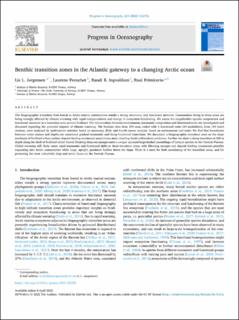Benthic transition zones in the Atlantic gateway to a changing Arctic ocean
Peer reviewed, Journal article
Published version
Permanent lenke
https://hdl.handle.net/11250/3004535Utgivelsesdato
2022Metadata
Vis full innførselSamlinger
- Articles [3009]
- Publikasjoner fra CRIStin [3056]
Sammendrag
The biogeographic transition from boreal to Arctic marine communities entails a strong taxonomic and functional turnover. Communities living in these areas are being strongly affected by climate warming with rapid reorganizations and change in ecosystem functioning. We assess the megabenthic species composition and functional character in a transition zone around Svalbard. The relationships between environment, taxonomic composition and functional traits are investigated and discussed regarding the potential impacts of climate warming. The biomass data from 293 taxa, coded with 6 functional traits (29 modalities), from 144 trawl stations, were analyzed by multivariate statistics based on taxonomy, RLQ- and fourth corner analysis, based on environment and traits. We find that boundaries between water masses and depths are associated gradual taxonomic and sharp functional transitions. We document a biogeographic transition zone on the slope northeast of Svalbard where surface deposit feeding crustacean associations meet crawling Arctic echinoderm predators. Further we show a sharp transition at 500 m depth along the shelf of Svalbard where boreal filtrating deep-sea sponges meet a unique upraised large-bodied assemblage of bathyal species on the Yermak Plateau. Global warming will likely cause rapid taxonomic and functional shifts in these transition areas, with filtrating sponges and deposit feeding crustaceans possibly expanding into Arctic communities while large, upright, predators further down the slope. There is a need for both monitoring of the transition areas, and for protecting the most vulnerable deep and arctic fauna on the Yermak Plateau.
